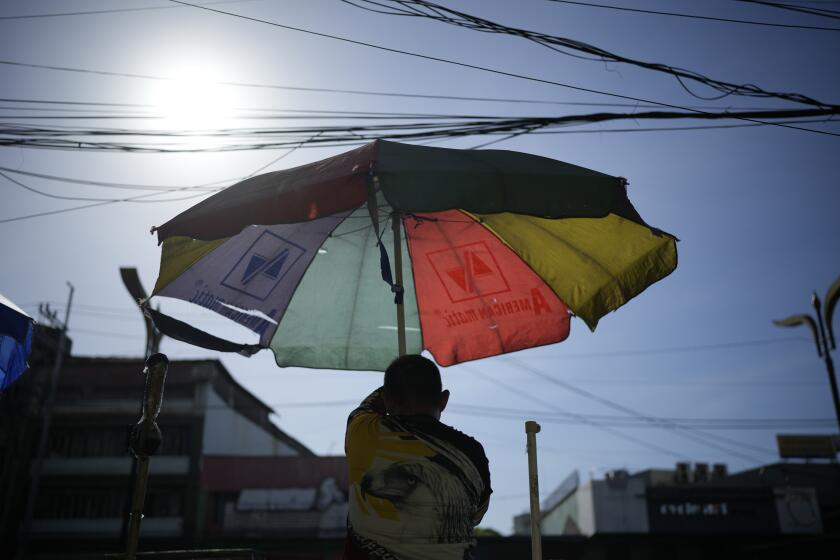Mediterranean Muse : A GHOST IN TRIESTE, <i> By Joseph Cary (University of Chicago Press: $27.50; 302 pp.)</i>
In 1382, the tiny walled port of Trieste put itself under the protection of the Holy Roman Empire out of fear of its aggressive neighbor, Venice. For five and a half centuries it was Austria’s Italy. In 1918, at the end of the First World War, it changed hands; and ever since, it has been Italy’s Austria.
An identity problem, but only one of many. Both under Austria and today, much of the population is of Slavic origin. For a few years after World War II, in fact, when the late Marshal Tito was feeling his oats and eyeing other people’s, Trieste very nearly became Yugoslavia’s Austro-Italy.
Then there is the matter of feeling rich or poor. In 1719 Austria granted the still-obscure town the status of a free port; later she built a trans-Alpine railroad connecting it to Vienna. By the 1850s it was the Mediterranean entrepot of a powerful and wealthy hinterland. Its population grew from 7000 to 160,000; it was the seventh busiest port in the world and the second in the Mediterranean, after Marseilles.
It was rich; also unhappy and confused. Its grand public buildings were Hapsburg schlag (italics) in stone. The letter-boxes were inscribed with the two-headed Imperial eagle. The letters inside, to the contrary, were inscribed in Italian sentences and nationalist aspirations. And once the aspirations bore fruit, Trieste, no longer the strategic Mediterranean port of an inland empire, was only one of a dozen ports in a not especially prosperous Mediterranean nation. Since 1918 the place has been in decline.
There are declines which, like those of roses, have a perfume. There are confusions of identity that are the most pervasive of identities. Trieste, which missed the visual glories of the Italian Renaissance and had to settle for a second-hand Austrian neo-Baroque, has other remains. The poet Eugenio Montale called it “the sole Italian city that derived its glory from its writers.” Yet even here, there is an identity question.
Loping into the question, perambulating around it, unfolding it like a card-trick done with too many cards, and dropping the cards, is Joseph Cary, a retired professor of comparative literature from Connecticut and, judging from “A Ghost in Trieste,” a very rare professor indeed. Instead of annexing his subject he has subjected himself to it. He has reached Trieste through his devotion to three writers who embody in one way or other the glory that Montale was addressing: Italo Svevo, the poet Umberto Saba and, by a kind of adoption, James Joyce, who lived and wrote in Trieste for a dozen years, before and briefly after World War I.
The three glories of Trieste, if you will, and yet in different ways quite apart from it. Joyce was a foreigner and wrote in English and eventually Joycespeak. Italo Svevo’s real name was Ettore Schmitz; he was of part- German origin and his work was almost entirely ignored, even in Trieste, where he was known to most as a prosperous paint-and-varnish manufacturer and a literary dabbler. Only with “The Confessions of Zeno” did he become famous. Aside from Montale’s recognition, the fame came largely from abroad, thanks to Joyce’s literary connections.
Svevo is not mentioned in “Literary Trieste,” an authoritative Italian study written in 1924; neither is Umberto Saba. To be authentically Triestine, both the study and the fashion of the time declared, you had to be rhetorical and ringingly nationalist. The existential irony of Svevo, and the limpidly personal introspection of Saba did not qualify; the writings of those who did are barely remembered. An identity problem, then and now.
Cary’s book is a ramble through Trieste, through history, and through the three writers who are both his subject and his pretext. (In the course of it we get his lovely translations of a dozen of Saba’s poems, whose solitary voice could break rocks and certainly hearts.) It is a ramble through the city’s perplexed identity--”Triestinitis: acute inflammation in response to whatever is Triestine, often transitory,” Cary quotes in an epigraph--and through his own equally perplexed identity as a literary pilgrim.
At the start of his project, he draws an equilateral triangle in his notebook to represent the three writers. Between 1905 and 1915 they were all in Trieste. “The lives of these must have touched in absorbing, unrecorded ways,” he speculates. Researching the supposed intersections and working in the libraries, but also walking the streets and brushing up against the grandchildren of those who had brushed up against his trio--surely this would fuse literary history with a redolent evocation of place. The stones would give up their sermons.
Many of us have done something similar--visited Keats’ house with nightingales in mind, only to come upon the prosaic streets of South Hampstead and a radio blaring out of a window beside the greengrocer’s. “The city,” Cary reports of his romantic project, “treated me ironically.” And from the start he treats himself ironically, as well. He is the opposite of simplistic and of course, no fool. If he acts the fool--ambling up to what was once Saba’s bookstore, he finds a pink arrow pointing to the Cinema Sexy, and I keep thinking of M. Hulot--it is for a purpose. The romantic and the ironic are two sides of a coin, yet Cary wedges himself in between.
Soon enough he concludes that the relations between Svevo and Joyce-- thoroughly documented in any case and bare of remaining mystery--were cordial but rather formal. Joyce and Saba never met. Saba and Svevo were only distantly acquainted. His equilateral literary triangle implodes; it will reconstitute itself as a squashed triangle--one obtuse angle and two acute ones--in an entirely different mode. Cary visits the public gardens, whose walks are lined with busts. Sure enough, there are the three: dilapidated likenesses of Joyce and Saba close together, Svevo a muddy way off.
Gimcrack material memorials to vibrant and immaterial spirits. Through most of his book, Cary explores the memorials: Trieste’s history, its notions of itself, its governors and revolutionaries, and the never very impressive buildings and streets in which its life has been played out. He writes of San Giusto, its patron martyr, chained to a boulder, thrown into the sea and miraculously floating back; of the German antiquities scholar, Johann Winckelmann, murdered in what may have been a homosexual tryst, and of Sir Richard Burton, the British consul, translating the Arabian nights on Her Majesty’s time. He writes of the mournful Hapsburg princeling, Maximilian, who began work on the lovely toy palace of Miramar--it still shimmers in sea haze just outside town--only to be dispatched to serve as Emperor of Mexico and almost immediately to be shot. Identity puzzles, all four.
Some of Cary’s histories are on the thin side. As for the perambulating, it is both unserious and serious. We learn that he only spent three weeks in Trieste over the course of five years. That hardly makes a believer’s pilgrimage, though the author tells us with faintly mock gravity: “The intervals supplied me with the perspective that the weeks on the spot semed to baffle...only at home, in the bosom of my patient family, did I acquire a point of view.”
Oddly enough, though, Cary succeeds. Even if Trieste frustrates his search for literary ghosts, the search was only a pretext. It accomplishes for us what it did not accomplish for him. M. Hulot discovers for us the gravity of absurdity. Cary brings us the sweet ramshackle city-state. If he finds his writers mainly in their books and hardly at all in their city that, after all, is where writers live.
More to Read
Start your day right
Sign up for Essential California for news, features and recommendations from the L.A. Times and beyond in your inbox six days a week.
You may occasionally receive promotional content from the Los Angeles Times.






